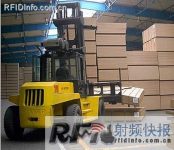
Swiss wood board manufacturer uses passive LF tags to manage inventory
[ad_1]
International plywood and particleboard manufacturer-Swiss Krono Holding Company is currently using RFID navigation systems in its warehouses in Hungary and Slovakia, and a system will be implemented in German warehouses in July. A total of more than 1,600 LF tags have been installed on each floor of each warehouse in these areas, which can track the movement of forklifts and loading and unloading planks.
The system has been installed in each warehouse in the three countries, but the company also plans to further expand the system to other regions. The system is mainly based on the technology developed by two companies in Bavaria: the inventory management software provider SEP Logistik and the real-time tracking system provider Indyon. The following is a detailed case analysis:
Joint efforts to develop RELAG software using RFID navigation system

The plywood warehouse in Hungary embeds passive LF RFID tags in the floor to track forklifts and transported wooden boards
The first to adopt this system was the Kronospan-Mofa Farostlemezgy¨¢rt¨® plant in Hungary. The company’s managers have always wanted to create a more efficient positioning system for positioning plywood and particleboard at the same time to conduct quality tests in batches to ensure that the earliest products can be sold at the earliest. In the past, the factory relied on checklists and employee memories to complete tracking tasks manually. There are a total of 200 types of plywood and particleboard in the pallets of the Kronospan-Mofa warehouse in Hungary. The measured height is 5 meters and the length is 15 to 20 meters.
SEP Logistik was found when Kronospan-Mofa in Hungary started planning a new warehouse. After that, the two companies jointly developed a solution-SEP Logistik proposed the RELAG software using RFID navigation system.
Hungarian Kronospan-Mofa is the first to test the RFID system
Kronospan-Mofa in Hungary has been using this system since the completion of the new warehouse in August 2007, installing 134kHz tags in the glass capsules on the concrete floor. These tags are provided by Texas Instruments and comply with the ISO 11784 standard. Each tag has a unique code number. All of this information is stored in the database and linked to the tag’s warehouse location information.
After the wood boards are produced, they are stacked in pallets, and then labels with ID codes and product descriptions are affixed to the front of the pallets. The driver uses a forklift equipped with a barcode scanner and RFID interrogator to pick pallets. The barcode scanner on the forklift reads the pallet label and transmits the information to the warehouse management system.
The system then sends the resulting information to the touch screen display of the forklift, instructing the driver to place the pallet on a specific pile. After the RFID reader installed on the forklift reads the tag, the computer system immediately updates the position of the forklift.
The location information obtained is mainly used to confirm that the specified wooden board cargo is placed in the specified storage stack. If the driver is driving in the wrong direction, the system will use this data to remind the driver to save time. After reaching the designated storage stack, the driver stacks the pallets and confirms the delivery information through the touch screen of the forklift. By reading the RFID tag, the system can double check the delivery of the pallet to the designated stack.
This process will happen again when loading the truck. After the forklift monitoring instructions, the company will pick pallets from a specific stack and send the pallets to the designated truck. Unlike the previous paper document list read near the forklift, the driver will determine where to place the pallet through electronic clues using RFID technology. Once the pallet is loaded on the truck, the warehouse management system records the exact time of loading and automatically generates a shipping receipt.

Unlike the previous paper document list read near the forklift, the driver will determine where to place the pallet through electronic clues using RFID technology
After the system is applied
Dietmar Rinne, director of Kronospan IT GmbH, a subsidiary of Krono Holdings, said that there were no technical problems during the installation of the system and there were no problems in operation. However, the company invested a lot of time and resources in training employees to use the system. The entire training period took 8 weeks to train 25 employees.
Rinne is responsible for integrating the RFID application with the company’s customized ERP software. Hungary’s Kronospan invested US$312,000 in the system, but has not yet calculated the return on investment due to lack of specific data to compare costs.
According to Rinne, the Kronospan wood board factory is very satisfied with the system, and workers can find and store wood boards much faster than in the past. On this basis, Kronospan is now able to perform more quality checks because the positioning of individual items has become faster. And because the goods can be found without document lists or employees’ memories, it can be ensured that they can sell the longest-storage planks first, thus avoiding the inventory from being left in the warehouse for too long.
In addition, Krono has implemented the same system in its warehouses in Warren and Slovakia, including more than 4,000 tags and eight RFID forklifts. The training process in Slovakia is faster and smoother than in Hungary. Currently, the Bischweier warehouse in Germany is also implementing this recognition system.
[ad_2]



